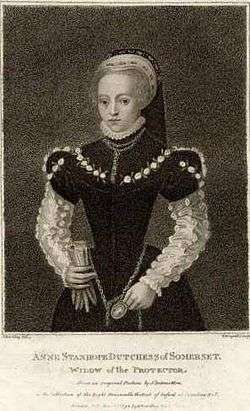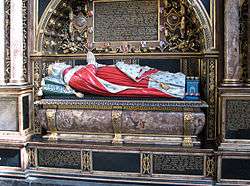Anne Seymour, Duchess of Somerset
| Anne Stanhope | |
|---|---|
|
Duchess of Somerset Countess of Hertford Viscountess Beauchamp | |
 Anne Seymour, Duchess of Somerset in a 19th century engraving | |
| Spouse(s) |
Edward Seymour, 1st Duke of Somerset Francis Newdigate |
|
Issue
Edward Seymour Edward Seymour, 1st Earl of Hertford Anne Dudley, Countess of Warwick Lady Jane Seymour Mary Seymour Elizabeth Seymour Lord Henry Seymour | |
| Father | Sir Edward Stanhope |
| Mother | Elizabeth Bourchier |
| Born | c. 1497 |
| Died |
16 April 1587 Hanworth Palace, Middlesex |
| Buried | Westminster Abbey, London |

Anne Seymour, Duchess of Somerset (née Stanhope) (c.1497 – 16 April 1587) was the second wife of Edward Seymour, 1st Duke of Somerset (c.1500-1552), who held the office of Lord Protector during the first part of the reign of his nephew King Edward VI, through whom Anne was briefly the most powerful woman in England. During her husband's time as Lord Protector she claimed precedence over the dowager queen Catherine.
Family
Anne Stanhope was born in 1497[1] the only child of Sir Edward Stanhope (1462 – 6 June 1511) by his wife Elizabeth Bourchier (b. before 1473, d. 1557),[2] a daughter of Fulk Bourchier, 10th Baron FitzWarin (1445-1479). By her father's first marriage to Adelina Clifton she had two half-brothers, Richard Stanhope (died 1529) and Sir Michael Stanhope.[3] After the death of Sir Edward Stanhope in 1511, his widow, Elizabeth, married Sir Richard Page of Beechwood, Hertfordshire.[4]
Her paternal grandparents were Thomas Stanhope, esquire, of Shelford and Margaret (or Mary) Jerningham,[5] and her maternal grandparents were Fulke Bourchier, 2nd Baron Fitzwaryn and Elizabeth Dynham. Through her mother, Anne was a descendant of Thomas of Woodstock, the youngest son of King Edward III of England and Philippa of Hainault.[6]
Anne's snobbery and pride were considered to be intolerable, yet she was highly intelligent and determined.[7] Antonio de Guaras, a Spanish merchant living in London, would later say of her, that she was "more presumptuous than Lucifer".[8]
First marriage
Anne Stanhope married Sir Edward Seymour sometime before 9 March 1535. Seymour's first marriage, to Catherine Fillol, had possibly been annulled, but his first wife was probably dead by then. Edward Seymour was the eldest brother of Jane Seymour, the third wife of Henry VIII. Shortly after the king's marriage to Jane in June 1536, Edward Seymour was elevated to the peerage as Viscount Beauchamp. In October 1537, after the birth of his royal nephew Edward, he was created Earl of Hertford. In 1547, he became a duke, so Anne became the Duchess of Somerset.
Issue
Anne had ten children by Edward Seymour:
- Edward Seymour, Viscount Beauchamp of Hache (12 October 1537 – 1539)
- Edward Seymour, 1st Earl of Hertford (second creation of that title) (22 May 1539 – 1621), married firstly in November 1560, Lady Catherine Grey, by whom he had two sons; he married secondly in 1582, Frances Howard; and thirdly in 1601, Frances Prannell (born Lady Frances Howard), widow of Henry Prannell.
- Lord Henry Seymour (1540–?) married Lady Joan Percy, daughter of Thomas Percy, 7th Earl of Northumberland
- Lady Anne Seymour (1538 – 1588), married firstly John Dudley, 2nd Earl of Warwick; she married secondly Sir Edward Unton, MP, by whom she had issue.* Lady Margaret Seymour (1540 - ?) noted Elizabethan author
- Lady Jane Seymour (1541–1561) Maid of Honour to Queen Elizabeth I, noted Elizabethan author
- Lady Catherine Seymour (1548–1625)
- Lord Thomas Seymour (1548–1574), unmarried and without issue
- Lady Mary Seymour (born 1552) married three times (Andrew Rogers, of Bryanstone, Dorset; Sir Henry Peyton, General Francis Cosbie)
- Lady Elizabeth Seymour (1552 – 3 June 1602), married Sir Richard Knightley, of Northamptonshire
Queen Jane stood godmother to Anne's first child. The ceremony was held at Chester Place; besides the queen, Thomas Cromwell and Mary Tudor also acted as godparents.[9]
Life in the royal court

 shown on escutcheons behind impaled by Seymour and impaling Bourchier. On the base are shown 4 Bourchier knots
shown on escutcheons behind impaled by Seymour and impaling Bourchier. On the base are shown 4 Bourchier knotsAnne Seymour was present at the wedding ceremony of Henry VIII and Catherine Parr on 12 July 1543.[10] After Henry VIII's death, her husband acted as king in all but name. With this power, the Duchess of Somerset considered herself the first lady of the realm, claiming precedence over Henry VIII's widow, following the latter's marriage to the Duke of Somerset's brother, Thomas Seymour.
The Duchess considered that Catherine Parr forfeited her rights of precedence when she married the younger brother of the Duchess's husband.[11] She refused to bear Catherine's train, and even physically tried to push her out of her place at the head of their entrances and exits at court.[12] The Duchess was quoted as having said of Catherine, "If master admiral (Thomas Seymour) teach his wife no better manners, I am she that will".[13] Catherine, in her turn, privately referred to her sister-in-law as "that Hell".[14] Catherine Parr won the battle by invoking the Third Succession Act which clearly stated that she had precedence over all ladies in the realm; in point of fact, as regards precedence, the Duchess of Somerset came after Queen Catherine, Princess Mary, Princess Elizabeth and Anne of Cleves. The Duchess, who was described as a "violent woman", wielded considerable power for a short time, which later would reflect negatively on her husband's reputation.
As Lord Protector, Edward Seymour wielded almost royal authority. However, he lost his position of power following a show-down between the Privy Council and himself in October 1549. He and his wife were imprisoned in the Tower of London. The Duchess was released after a short time,[15] Somerset himself in January 1550.[16] According to the Imperial ambassador Jehan de Scheyfye, Anne Seymour had made daily visits to the house of the de facto new ruler, John Dudley, Earl of Warwick, who soon allowed Somerset to rejoin the Privy Council. The Duchess of Somerset and the Countess of Warwick then arranged a marriage between their respective eldest son and daughter, Anne Seymour and John Dudley.[17] Somerset fell again into disgrace in October 1551, when he was arrested on charges of conspiring against Warwick, who had recently been created Duke of Northumberland. Somerset was convicted of felony on 1 December 1551 and beheaded on 22 January 1552 on Tower Hill. The Duchess of Somerset had been arrested with her husband and continued in the Tower until 30 May 1553.[18] After Mary I's accession in July and the attainder of the Duke of Northumberland she was allowed to choose from the Dudley family's confiscated household stuffs.[19]
Second marriage
Anne Seymour married secondly Francis Newdigate (d. 26 January 1582) of Hanworth, Middlesex, who had been steward to her late husband. Newdigate was a younger son of John Newdigate, of Harefield, Middlesex.[20] Little is known of their life together.
Death
Anne Seymour died at Hanworth Palace,[21] Middlesex, on 16 April 1587, and was buried in Westminster Abbey,[22] where her tomb with its painted effigy can be viewed.
In fiction
She is played by Kathleen Byron in "Young Bess". The portrayal is a faithful rendition of the real Anne Seymour. [23]She is played by Emma Hamilton in the historical fiction series The Tudors in which her character is based partly on Edward Seymour's first wife, Catherine Fillol, who is rumoured to have had an affair with her father-in-law, and partly on the actual Anne Stanhope. In the series Anne is depicted as a woman who sleeps with many men and is known in France as a "woman of many talents" according to the Earl of Surrey. Her affairs on the show include Sir Francis Bryan and Sir Thomas Seymour (her brother-in-law). In the show, as a result of her affair with Sir Thomas, she has an illegitimate child with him, who is also named Thomas.
Ancestry
| Ancestors of Anne Seymour, Duchess of Somerset | ||||||||||||||||||||||||||||||||||||||||||||||||||||||||||||||||||||||||||||||||||||||||||||||||||||||||||||||||||||||||||||||||||||||||||||||||||||||||||||||||||||||||||||||||||||||||||||||||||||||||||||||||||||||||||||||||||||||||||||||||||||||||||||||||||||||||||||||||||||||||||||||||||||||||||||||||||||||||||||||||||||||||||||||||||||||||||||||||||||||||||||||||||||||||||||||||||||||||||||||||||||||||||||||||||||||||||||||||||||||||||||||||||||||||||||||||||||||||||||||||||||||||||||||||||||||||||||||||||
|---|---|---|---|---|---|---|---|---|---|---|---|---|---|---|---|---|---|---|---|---|---|---|---|---|---|---|---|---|---|---|---|---|---|---|---|---|---|---|---|---|---|---|---|---|---|---|---|---|---|---|---|---|---|---|---|---|---|---|---|---|---|---|---|---|---|---|---|---|---|---|---|---|---|---|---|---|---|---|---|---|---|---|---|---|---|---|---|---|---|---|---|---|---|---|---|---|---|---|---|---|---|---|---|---|---|---|---|---|---|---|---|---|---|---|---|---|---|---|---|---|---|---|---|---|---|---|---|---|---|---|---|---|---|---|---|---|---|---|---|---|---|---|---|---|---|---|---|---|---|---|---|---|---|---|---|---|---|---|---|---|---|---|---|---|---|---|---|---|---|---|---|---|---|---|---|---|---|---|---|---|---|---|---|---|---|---|---|---|---|---|---|---|---|---|---|---|---|---|---|---|---|---|---|---|---|---|---|---|---|---|---|---|---|---|---|---|---|---|---|---|---|---|---|---|---|---|---|---|---|---|---|---|---|---|---|---|---|---|---|---|---|---|---|---|---|---|---|---|---|---|---|---|---|---|---|---|---|---|---|---|---|---|---|---|---|---|---|---|---|---|---|---|---|---|---|---|---|---|---|---|---|---|---|---|---|---|---|---|---|---|---|---|---|---|---|---|---|---|---|---|---|---|---|---|---|---|---|---|---|---|---|---|---|---|---|---|---|---|---|---|---|---|---|---|---|---|---|---|---|---|---|---|---|---|---|---|---|---|---|---|---|---|---|---|---|---|---|---|---|---|---|---|---|---|---|---|---|---|---|---|---|---|---|---|---|---|---|---|---|---|---|---|---|---|---|---|---|---|---|---|---|---|---|---|---|---|---|---|---|---|---|---|---|---|---|---|---|---|---|---|---|---|---|---|---|---|---|---|---|---|---|---|---|---|---|---|---|---|---|---|---|---|---|---|---|---|---|---|---|---|---|---|---|---|---|---|---|---|---|---|---|---|---|---|---|---|---|---|---|---|---|---|---|---|---|---|---|---|---|---|---|---|---|---|---|---|---|---|---|---|---|---|---|---|---|---|---|---|---|---|---|---|---|---|---|---|---|---|---|---|---|---|---|---|---|---|---|---|---|---|---|---|---|---|---|---|---|---|---|---|---|---|---|---|
| ||||||||||||||||||||||||||||||||||||||||||||||||||||||||||||||||||||||||||||||||||||||||||||||||||||||||||||||||||||||||||||||||||||||||||||||||||||||||||||||||||||||||||||||||||||||||||||||||||||||||||||||||||||||||||||||||||||||||||||||||||||||||||||||||||||||||||||||||||||||||||||||||||||||||||||||||||||||||||||||||||||||||||||||||||||||||||||||||||||||||||||||||||||||||||||||||||||||||||||||||||||||||||||||||||||||||||||||||||||||||||||||||||||||||||||||||||||||||||||||||||||||||||||||||||||||||||||||||||
References
- ↑ Sylvanus Urban, The Gentleman's Magazine, April 1845, p. 371
- ↑ Marshall 1871, p. 7; Warnicke 2004
- ↑ Marshall 1871, p. 7.
- ↑ Marshall 1871, p. 7; Warnicke 2004; Davies 2004.
- ↑ Marshall 1871, p. 6.
- ↑ Anthony Martienssen, Queen Katherine Parr, p.125
- ↑ Martienssen, p.125
- ↑ Antonia Fraser, The Wives of Henry VIII, p. 235
- ↑ Fraser. p. 275
- ↑ Martienssen, pp.153-54
- ↑ Martienssen, p. 231
- ↑ Martienssen, p.231
- ↑ Fraser, p.402
- ↑ Fraser, p. 403
- ↑ Loades p. 150
- ↑ Beer, p. 95
- ↑ Beer, pp. 95–96
- ↑ Loades, pp. 188–190
- ↑ Beer, p. 196
- ↑ Cokayne 1953, p. 64.
- ↑ Warnicke 2004.
- ↑ Cokayne 1953, p. 64.
- ↑ imdb.com
- ↑ Pine 1972, p. 65.
- ↑ Burke 1914, p. 1082.
- ↑ Pine 1972, p. 65.
- ↑ Burke 1914, p. 1082.
- ↑ Burke 1914, p. 1082.
External links
- Cokayne, George Edward (1953). The Complete Peerage, edited by Geoffrey H. White. XII, Part I. London: St Catherine Press. pp. 59–65.
- Davies, Catharine (2004). "Page, Sir Richard (d. 1548)". Oxford Dictionary of National Biography (online ed.). Oxford University Press. doi:10.1093/ref:odnb/70795. (Subscription or UK public library membership required.)
- Marshall, George William, ed. (1871). The Visitations of the County of Nottingham in the Years 1569 and 1614. London: Harleian Society. pp. 6–7. Retrieved 4 April 2013.
- Richardson, Douglas (2011). Everingham, Kimball G., ed. Magna Carta Ancestry: A Study in Colonial and Medieval Families. I (2nd ed.). Salt Lake City. p. 282. ISBN 1449966373.
- Stanhope, Philip Henry (1855). Notices of the Stanhopes as Esquires and Knights. London: A. and G.A. Spottiswoode. Retrieved 31 March 2013.
- Warnicke, Retha M. (2004). "Seymour, Anne, duchess of Somerset (c.1510–1587)". Oxford Dictionary of National Biography (online ed.). Oxford University Press. doi:10.1093/ref:odnb/68053. (Subscription or UK public library membership required.)
- Barrett L. Beer, Northumberland: The Political Career of John Dudley, Earl of Warwick and Duke of Northumberland, 1973, The Kent State University Press, ISBN 0-87338-140-8
- David Loades: John Dudley, Duke of Northumberland 1504–1553, 1996, Clarendon Press ISBN 0-19-820193-1
- Antonia Fraser, The Wives of Henry VIII, Alfred A. Knopf, New York, 1992, ISBN 0-394-58538-0
- Anthony Martienssen, Queen Katherine Parr, McGraw-Hill Book Co., New York, St. Louis, San Francisco, Düsseldorf, Mexico, 1973 ISBN 0-07-040610-3